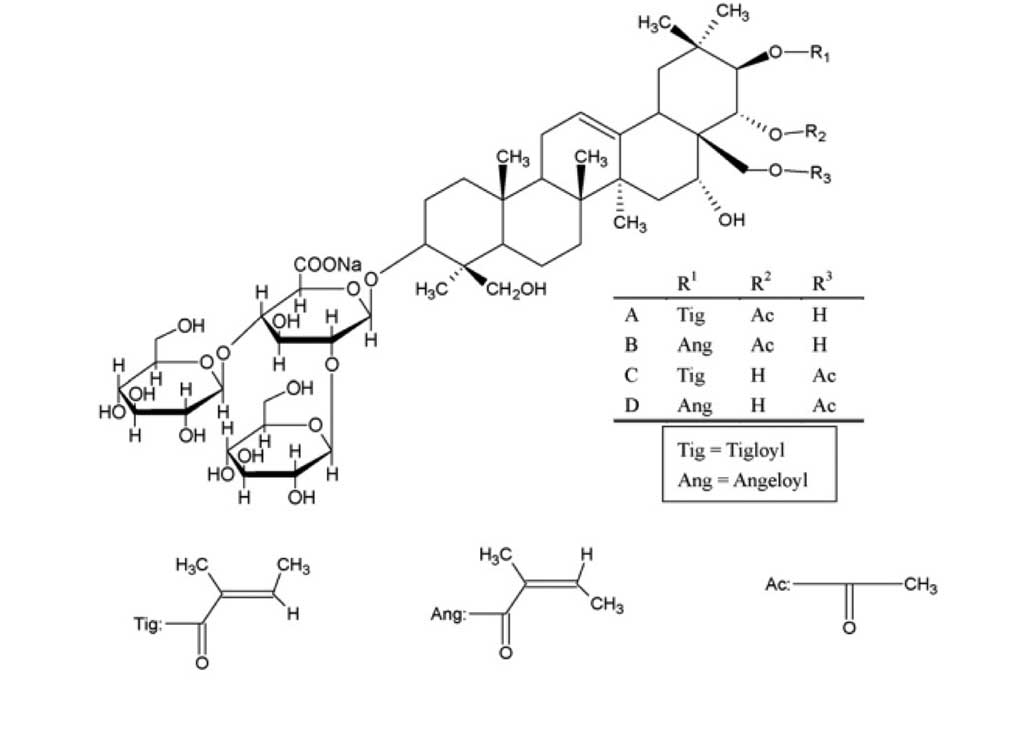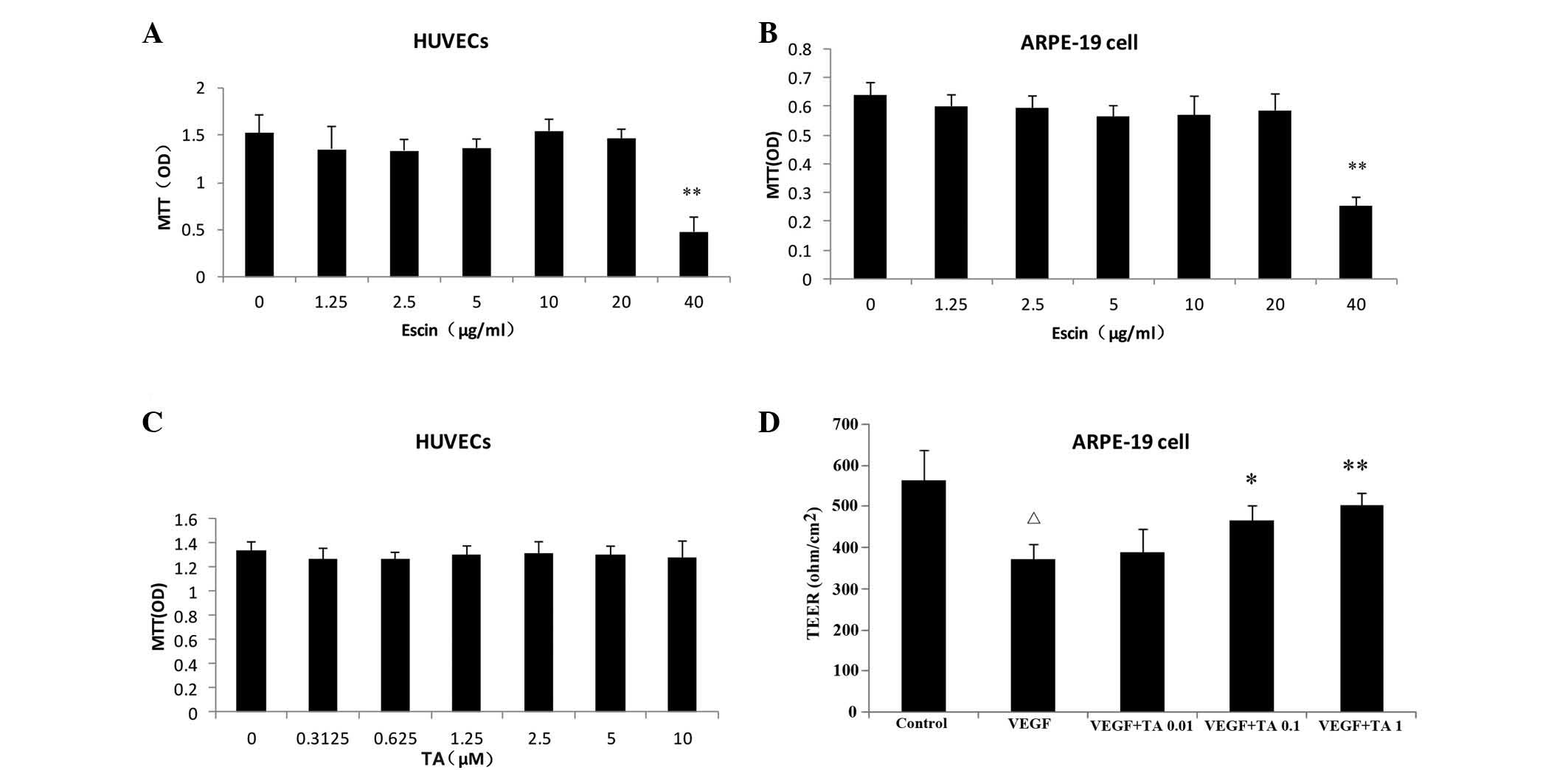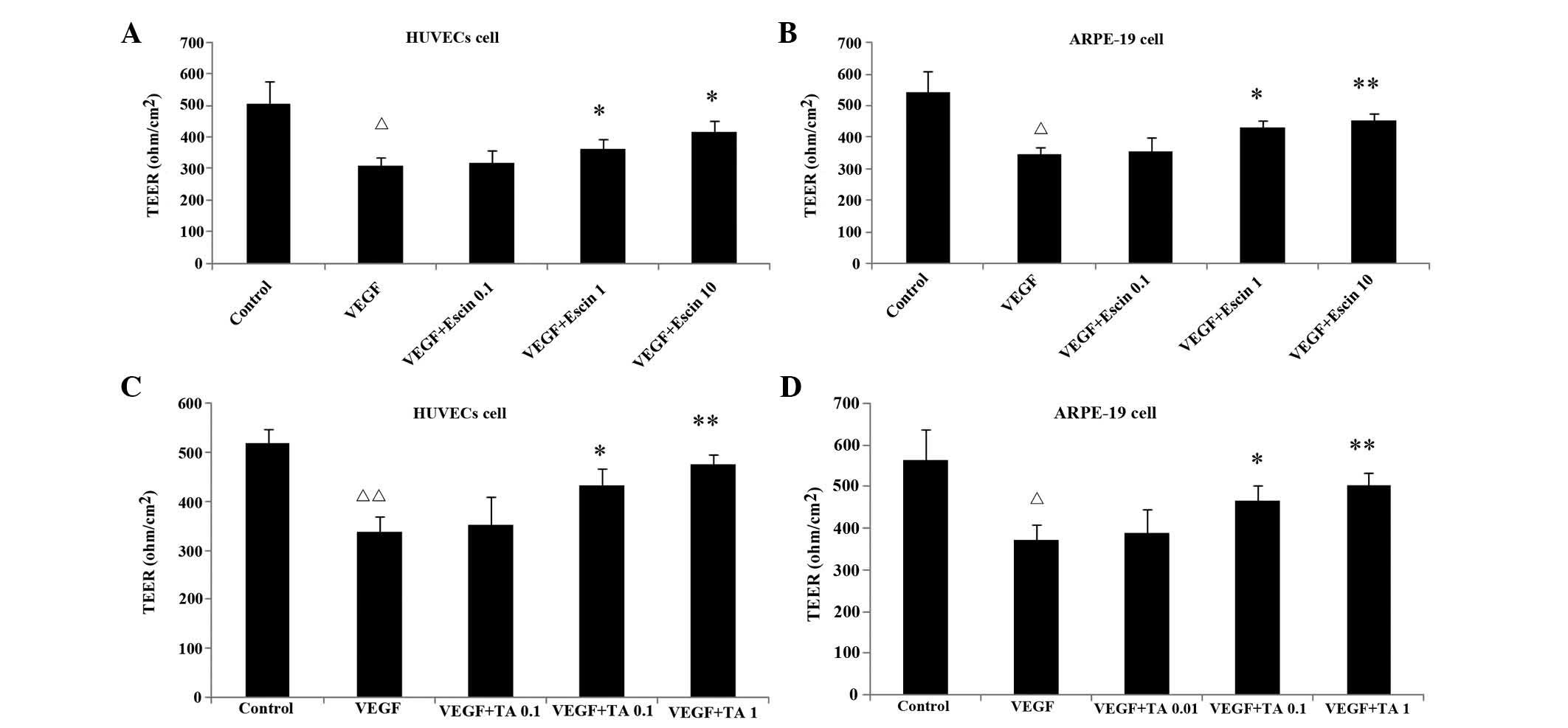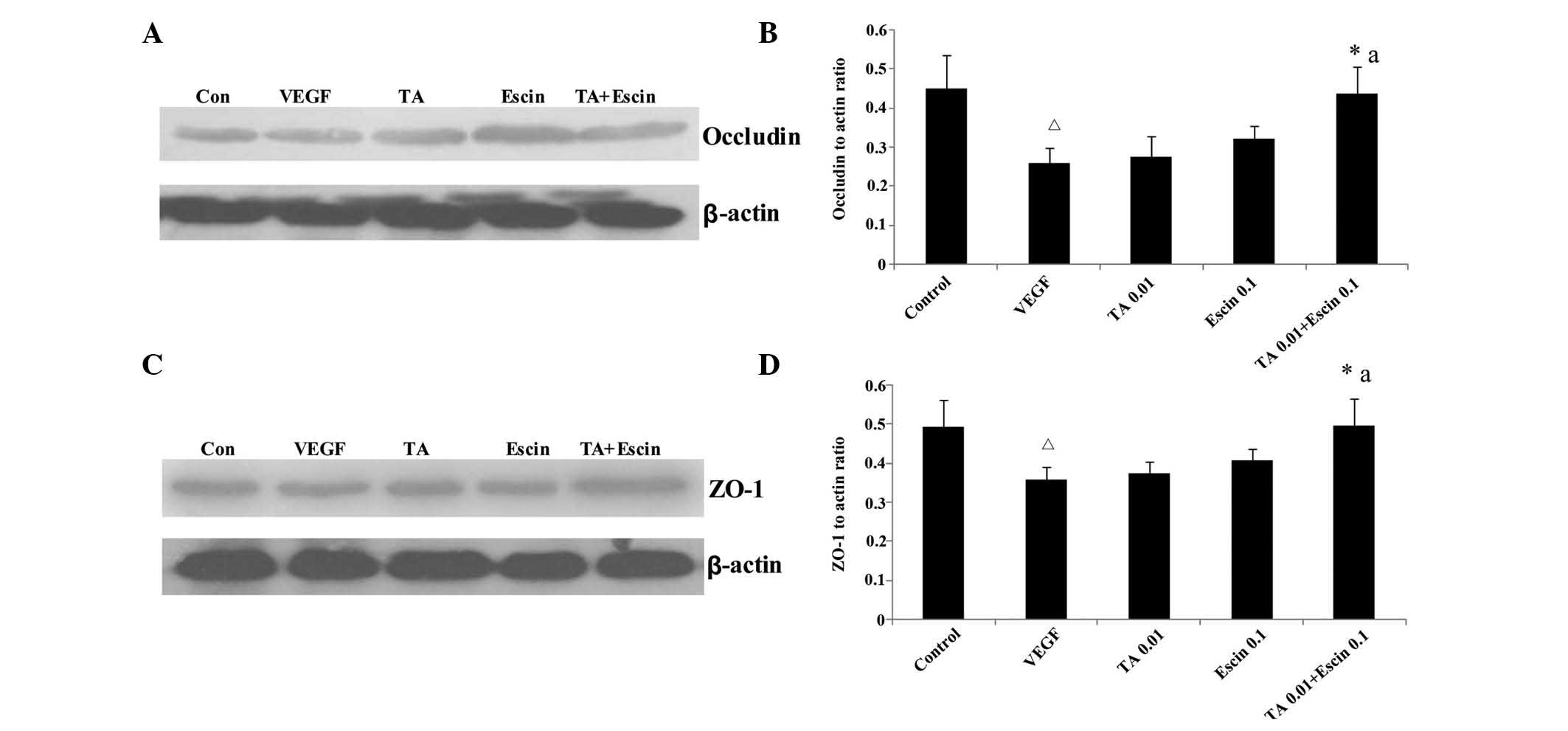Synergistic protective effects of escin and low‑dose glucocorticoids against vascular endothelial growth factor‑induced blood‑retinal barrier breakdown in retinal pigment epithelial and umbilical vein endothelial cells
- Authors:
- Published online on: October 31, 2014 https://doi.org/10.3892/mmr.2014.2833
- Pages: 1372-1377
Abstract
Introduction
Breakdown of the blood-retinal barrier (BRB) is an early event in the pathogenesis of diabetic retinopathy (DR) (1). One consequence of BRB breakdown in diabetics is the accumulation of plasma protein and osmotically obliged fluid in the neural interstitium. This causes pathological retinal swelling, neuronal disorganization and vision loss.
Vascular endothelial growth factor (VEGF), one of the vascular permeability factors, mediates increased vascular permeability and colocalizes with extravasated albumin in major retinal diseases such as DR (2,3). Increased levels of VEGF have been shown to induce a reduction in the expression levels of occludin and ZO-1, two important junctional proteins that are expressed in vascular endothelial junctional complexes, thereby leading to increased tissue permeability (4).
Glucocorticoids (GCs) have been shown experimentally to reduce the breakdown of the BRB by directly affecting the endothelial cells through regulating the phosphorylation, organization and content of tight junction proteins (5). It has been reported that triamcinolone acetonide (TA) can upregulate the expression of the tight junction transmembrane protein occludin in animals (6). Although GCs have been shown to ameliorate macular edema, the side effects accompanying treatment make their frequent use problematic. One of the major side effects of intravitreal injection of TA is a steroid-induced increase in intraocular pressure (IOP). One study demonstrated that a rise in IOP to values higher than 21 mmHg is expected to occur in ~50% of the eyes treated (7). The frequency of cataract surgery following intravitreal injection of high-concentration TA in elderly patients is increasing (8).
Escin is a natural mixture of triterpene saponins, which mainly consists of A, B, C and D escin (Fig. 1). Previous studies have indicated that escin exerts anti-inflammatory and anti-edematous effects (9,10). Escin has been reported to be a safe and potent anti-inflammatory agent with a long-lasting, effective anti-inflammatory action without immunosuppression (11,12). It also exerts synergistic anti-inflammatory effects with low doses of GCs in vivo and in vitro (13). In China, escin is widely used clinically for the treatment of retinal vein occlusion and central serous chorioretinopathy (14–16).
The current study was designed to investigate whether a combination of escin and GCs could produce synergistic protective effects against BRB breakdown in retinal pigment epithelial (RPE) cells and human umbilical vein endothelial cells (HUVECs).
Materials and methods
Drugs and cells
Sodium aescinate, for injection with escin, was obtained from Shandong Luye Pharmaceutical Company Limited (batch no.: 1212024; Yantai, China). Triamcinolone acetonid (batch no.: SLBB0079V; Sigma-Aldrich, St. Louis, MO, USA) was dissolved in 100% dimethyl sulfoxide (DMSO; Sigma-Aldrich) and diluted with DMSO and the appropriate cell culture medium to the desired concentration, with a final DMSO concentration of 0.1% for in vitro studies. DMSO was added to cultures at 0.1% (v/v) as a solvent control. ARPE-19 human RPE cell cultures, were obtained from the Shandong Eye Institute (Qingdao, China). HUVECs were obtained from Shandong Luye Pharmaceutical Company Limited (Yantai, China). Limited Dulbecco’s modified Eagle medium (DMEM; Gibco-BRL, Carlsbad, CA, USA) supplemented with 10% fetal calf serum (FCS; Gibco-BRL) and 1% penicillin/streptomycin (Beyotime Institute of Biotechnology, Haimen, China) was used as the cell culture medium. Cells were cultured in a humidified atmosphere of 5% CO2 in air at 37°C.
Cell culture
ARPE-19 cells and HUVECs were cultured in 5 ml complete medium dishes. When the culture reached 90% confluence, usually after ~4–5 days, cells were washed twice with sterile D-Hank’s solution (Beyotime Institute of Biotechnology) and separated by short trypsinization (0.05% trypsin-EDTA; Invitrogen, Carlsbad, CA, USA). The remaining trypsin-EDTA was removed, the tubes were gently shaken until cells were completely ablated and then supplemented with complete DMEM. The pellet was agitated with a pipette. Cells were transferred to three culture bottles and incubated for all experiments.
MTT assay
HUVECs (100 μl) and ARPE-19 (100 μl) cells were seeded into 96-well plates at a density of 4×104 cells per well. The cells were seeded on the bottom side of the well and cultured in complete DMEM at 37°C in 5% CO2 for 24 h. To investigate the effects of different concentrations of escin and TA on the viability of HUVECs and ARPE-19 cells, following the 24-h culture, the cells were treated with escin at final concentrations of 1.25, 2.5, 5, 10, 20 and 40 μg/ml for another 24 h. TA was added to each well at final concentrations of 0.3125, 0.625, 1.25, 2.5, 5 and 10 μmol/l for another 24 h. The controls were maintained in complete culture without penicillin/streptomycin for the same time period. Following treatment with TA the MTT assay was carried out. In short, the medium was removed, the cells were washed with phosphate-buffered saline (PBS), and 150 μl MTT solution (5 mg/ml) was added to each well. ARPE-19 cells and HUVECs were incubated at 37°C for 4 h. The medium was removed and the solution aspirated. The resulting formazan crystals were dissolved in 150 μl DMSO per well. Absorption was measured with a scanning multi-well spectrophotometer (SpectraMax M3; Molecular Devices, Sunnyvale, CA, USA) at a wavelength of 570 nm. The results are expressed as the mean of the percentage of proliferation, with the control set as 100% proliferation.
Tight junction building
DMEM was added into a 24-well plate with Transwell inserts (diameter 6.5 mm, pore size 0.45 μm; Corning Costar, Canton, MA, USA). HUVECs and ARPE-19 cells (4×104 cells per transwell insert) in a volume of 100 μl were seeded on the bottom side of the insert. The medium was changed every two days. Under these conditions, the formation of tight junctions between cells was detected using the cell resistance meter (Millicell-ERS; Millipor, Billerica, MA, USA). The barrier properties were assessed by daily TEER measurements. TEER was not stable until ~2–3 weeks and in vitro BRB models were established. Measurements were performed at 37°C and are expressed as relative values after subtracting TEER values from the inserts without cells.
Permeability analysis
Once cell tight junctions had been established, 2 μl recombinant human (rh)VEGF (batch no: F0311; Santa Cruz Biotechnology, Santa Cruz, CA, USA) was added (final concentration: ARPE-19 cells 10 ng/ml; HUVECs 100 ng/ml) along with escin ( 0.1, 1 or 10 μg/ml), TA (0.01, 0.1, or 1 μmol/l) or TA combined with escin. Each concentration was added to three parallel wells. The blank control was kept in complete culture except for rhVEGF and antibiotics. At 12 h, the effects of the agents on the cell tight junctions were detected by the cell resistance meter.
Protein extraction and western blotting
HUVECs (200 μl; 8×105 cells per transwell insert) were added to each well. The HUVECs in 30-mm tissue culture dishes were incubated in a humidified atmosphere of 5% CO2 in air at 37°C for 7 days. After 7 days, cells were stimulated with rhVEGF (VEGF). HUVECs were randomly divided into control, VEGF (100 ng/ml), VEGF + TA (0.01 μmol/L), VEGF + escin (0.1 μg/ml) and VEGF+ TA (0.01 μmol/L) + escin (0.1 μg/ml) groups. HUVECs were incubated in air at 37°C for 12 h. Following incubation the HUVECs were homogenized on ice in cold lysis buffer (Beyotime Institute of Biotechnology) plus 1:100 volume of phenylmethyl sulfonylfluoride. The homogenates were centrifuged at 14,000 × g for 5 min at 4°C. The supernatants were aliquoted and stored at −80°C following the removal of a small aliquot for protein estimation. Protein concentrations were determined using a bicinchoninic acid (BCA) Protein Assay kit (Beyotime). The samples were thawed on ice, mixed with 4× sample buffer (Invitrogen) and heated at 100°C for 5 min. Equivalent amounts of proteins (50 μg) were loaded onto 12% Tris-glycine, SDS-polyacrylamide gels for fractionation at 160 V. Predetermined molecular weight standards (Beyotime Institute of Biotechnology) were used as markers. Proteins on the gel were blotted onto nitrocellulose membranes (Beyotime Institute of Biotechnology) at 106 V for 70 min at 4°C. Following transfer, the membranes were incubated with a blocking buffer (5% skim milk in a washing buffer) for 2 h at room temperature and washed three times (5 min/wash) with 0.1% Tween 20 in Tris-buffered saline (TBST). Incubation with occludin (cat.no ab31721), ZO-1 (cat.no. ab59720) or GC receptor (cat.no. ab3578) antibodies (all supplied by Abcam, Cambridge, MA, USA) in diluent buffer (5% bovine serum albumin (Beyotime Institute of Biotechnology) and 0.1% TBST) was performed overnight at 4°C (1:1000 dilution). The membrane was subsequently washed three times (5 min per wash) with TBST. The primary antibody was probed with horseradish peroxidase-conjugated IgG secondary antibody (1:2000) for 2 h, washed three times in TBST and processed with enhanced chemiluminescence detection reagents (Beyotime). The processed membrane was exposed to photographic films for visualization of the signal. A β-actin western blot was performed for each membrane as an internal protein loading control.
Evaluation of drug interactions
The interaction between escin and TA was analyzed using the Berenbaum method to determine whether the combination was synergistic. The method is performed based on the following equation: E(da,db)<E(da) + E(db), where E is the observed effect, da and db are the doses of agents a and b. Synergism is indicated when the total effect of a combination is greater than expected from the sum of its effects (17).
Statistical analysis
Quantitative data from the experiments are expressed as the mean ± standard deviation, significance was determined by one-way analysis of variance followed by Tukey’s test. In all cases, P<0.05 was considered to indicate a statistically significant difference.
Results
Effects of escin and TA on the HUVECs and ARPE-19 cells survival rate
The results of the viability testing showed that escin at a final concentration of <20 μg/ml had no effect on the cell viability of either cell line and was chosen for all further experiments regarding tissue permeability, junctional protein, and receptor expression. All experimental concentrations of TA had no effects the cell viability of the two cell lines (Fig. 2).
Effects of escin and TA on TEER of the HUVECs and ARPE-19 cells
The TEER of cellular tight junctions in the VEGF group was significantly lower than that of control group (P<0.05). Escin (1, 10 μg/ml) and TA (0.1, 1 μmol/l) significantly increased the reduced TEER in cells stimulated with VEGF compared with that in the VEGF-treated control cells (P<0.05 or P<0.01) (Fig. 3). Escin (0.1 μg/ml) and TA (0.01 μmol/L) administered separately had no significant impact on the TEER of cellular tight junctions, however, administered together they significantly increased the TEER of cellular tight junctions in the presence of VEGF (P<0.05) (Fig. 4).
Effects of TA combined with escin on the expression levels of occludin and ZO-1 in HUVECs
Compared with the control group, the occludin and ZO-1 protein expression levels in HUVECs treated with VEGF was significantly reduced (P<0.05). Low concentrations of escin or TA alone did not enhance the occludin and ZO-1 expression levels compared with those observed in the VEGF group. However, when escin and TA were administered together, occludin and ZO-1 expression levels increased significantly compared with those of the control group (P<0.05) (Fig. 5).
Effects of TA combined with escin on GC receptor expression of HUVECs
Low dose escin or TA alone did not enhance the GC receptor expression compared with the VEGF group. However, when escin and TA were administered together, GC receptor expression increased significantly (P<0.05) (Fig. 6).
Discussion
The BRB is composed of tight and adherent junction complexes. Retinal vascular endothelium and pigment epithelium have well developed tight junctions that confer a high degree of control on solute and fluid permeability, which maintains the neural environment of retina. Intact BRB function is essential for proper vision and its breakdown greatly contributes to the pathology and vision loss in retinal disorders including DR, age-related macular degeneration and uveitis.
TEER measurement is a common method for evaluating the formation of tight junctional complexes. The present study used an in vitro model of BRB based on ARPE-19 cells and HUVECs on permeable transwell inserts. The BRB model established the tightness of the created monolayer as reflected by high TEER and high expression levels of adherens and tight junctional proteins. Occludin and ZO-1 are two important transmembrane proteins in tight junctions that are responsible for forming the permeability barrier (18).
VEGF has an important role in BRB breakdown (19,20). Elevated levels of VEGF can alter the integrity of the BRB and increase the vascular permeability in a number of pathological conditions, including diabetic macular edema (21,22). In the present study, following VEGF treatment, TEER and the expression levels of the tight junctional proteins occludin and ZO-1 were significantly reduced. The levels of TEER and tight junctional proteins in cells treated with escin (1, 10 μg/ml) and TA (0.1, 1 μmol/l) were significantly increased when compared with those observed in control cells treated VEGF. Separately, escin (0.1 μg/ml) and TA (0.01 μmol/L) had no significant impact on the TEER and cellular tight junctions, however, when administered together they significantly inhibited the reduction of TEER, indicating that escin and TA have synergistic effects which reduce BRB breakdown.
Currently, GCs are the most commonly used medicine for ocular diseases. Several studies have reported on the efficacy and complications associated with intravitreal GC injection for the treatment of diabetic macular edema (23,24). GCs may act by suppressing inflammation and directly affecting the endothelial cells through regulating the phosphorylation, organization, and content of tight junction proteins. The effect of GCs is dependent on the GC receptor as demonstrated by siRNA (25). In the present study, administration of escin and TA together increased GC receptor expression significantly, which may be one of the mechanisms by which escin protects against the BRB breakdown.
In conclusion, escin and GCs have synergistic protective effects on BRB breakdown, and the molecular mechanism is related to the upregulation of occludin and ZO-1. Administration of escin allows for the reduction of the dose of GCs for treatment of macular edema. The combination of escin with GCs indicates a beneficial method for the treatment of BRB breakdown.
Acknowledgements
This study was supported by the Project of Yantai Science and Technology Development Program (no. 2013WS205).
References
|
Sander B, Larsen M, Moldow B and Lund-Andersen H: Diabetic macular edema: passive and active transport of fluorescein through the blood-retina barrier. Invest Ophthalmol Vis Sci. 42:433–438. 2001.PubMed/NCBI | |
|
Qaum T, Xu Q, Joussen AM, et al: VEGF-initiated blood-retinal barrier breakdown in early diabetes. Invest Ophthalmol Vis Sci. 42:2408–2413. 2001.PubMed/NCBI | |
|
Mathews MK, Merges C, McLeod DS and Lutty GA: Vascular endothelial growth factor and vascular permeability changes in human diabetic retinopathy. Invest Ophthalmol Vis Sci. 38:2729–2741. 1997. | |
|
Kernt M, Thiele S, Liegl RG, et al: Axitinib modulates hypoxia-induced blood-retina barrier permeability and expression of growth factors. Growth Factors. 30:49–61. 2012. View Article : Google Scholar | |
|
Wilson CA, Berkowitz BA, Sato Y, Ando N, Handa JT and de Juan E Jr: Treatment with intravitreal steroid reduces blood-retinal barrier breakdown due to retinal photocoagulation. Arch Ophthalmol. 110:1155–1159. 1992. View Article : Google Scholar : PubMed/NCBI | |
|
McAllister IL, Vijayasekaran S, Chen SD and Yu DY: Effect of triamcinolone acetonide on vascular endothelial growth factor andoccludin levels in branch retinal vein occlusion. Am J Ophthalmol. 147:838–846. 2009. View Article : Google Scholar | |
|
Jonas JB, Kreissig I and Degenring R: Intraocular pressure after intravitreal injection of triamcinolone acetonide. Br J Ophthalmol. 87:24–27. 2003. View Article : Google Scholar | |
|
Jonas JB, Degenring R, Vossmerbauemer U and Kamppeter B: Frequency of cataract surgery after intravitreal injection of high-dosage triamcinolone acetonide. Eur J Ophthalmol. 15:462–464. 2005.PubMed/NCBI | |
|
Zhang L, Fu F, Zhang X, Zhu M, Wang T and Fan H: Escin attenuates cognitive deficits and hippocampal injury after transient global cerebral ischemia in mice via regulating certain inflammatory genes. Neurochem Int. 57:119–127. 2010. View Article : Google Scholar : PubMed/NCBI | |
|
Xin W, Zhang L, Fan H, Jiang N, Wang T and Fu F: Escin attenuates acute lung injury induced by endotoxin in mice. Eur J Pharm Sci. 42:73–80. 2011. View Article : Google Scholar | |
|
Wang T, Fu F, Zhang L, Han B, Zhu M and Zhang X: Effects of escin on acute inflammation and the immune system in mice. Pharmacol Rep. 61:697–704. 2009. View Article : Google Scholar : PubMed/NCBI | |
|
Zhang L, Wang H, Fan H, et al: The potent anti-inflammatory agent escin does not increase corticosterone secretion and immune cell apoptosis in mice. Fitoterapia. 82:861–867. 2011. View Article : Google Scholar : PubMed/NCBI | |
|
Xin W, Zhang L, Sun F, et al: Escin exerts synergistic anti-inflammatory effects with low doses of glucocorticoids in vivo and in vitro. Phytomedicine. 18:272–277. 2011. View Article : Google Scholar | |
|
Gong YY, Yu SQ, Wang H, et al: Clinical therapy of retinal vein occlusion with aescuven forte. Chin J New Drugs Clin Rem. 12:965–968. 2005. | |
|
Wang W, Gong Y, Wang H, et al: Aescuven forte in treating central serous chorioretinopathy. Chin J New Drugs Clin Rem. 12:961–964. 2005. | |
|
Yuan YL and Wu LL: Clinical observation of the central serous chorioretinopathy treated by aescinate sodium tablets combined with argon laser. Guiding Journal of TCM and Pharmacology. 15:58–59. 2009.(In Chinese). | |
|
Berenbaum MC: What is synergy? Pharmacol Rev. 41:93–141. 1989.PubMed/NCBI | |
|
Furuse M, Hirase T, Itoh M, et al: Occludin: a novel integral membrane protein localizing at tight junctions. J Cell Biol. 123:1777–1788. 1993. View Article : Google Scholar : PubMed/NCBI | |
|
Shibuya M: Vascular endothelial growth factor receptor-1 (VEGFR-1/Flt-1): a dual regulator for angiogenesis. Angiogenesis. 9:225–230. 2006. View Article : Google Scholar : PubMed/NCBI | |
|
Duh EJ, Yang HS, Suzuma I, et al: Pigment epithelium-derived factor suppresses ischemia-induced retinal neovascularization and VEGF-induced migration and growth. Invest Ophthalmol Vis Sci. 43:821–829. 2002.PubMed/NCBI | |
|
Esser S, Wolburg K, Wolburg H, et al: Vascular endothelial growth factor induces endothelial fenestrations in vitro. J Cell Biol. 140:947–959. 1998. View Article : Google Scholar : PubMed/NCBI | |
|
Antonetti DA, Barber AJ, Hollinger LA, Wolpert EB and Gardner TW: Vascular endothelial growth factor induces rapid phosphorylation of tight junction proteins occludin and zonula occluden-1. A potential mechanism for vascular permeability in diabetic retinopathy and tumors. J Biol Chem. 274:23463–23467. 1999. View Article : Google Scholar : PubMed/NCBI | |
|
Stewart MW: Corticosteroid use for diabetic macular edema: old fad or new trend? Curr Diab Rep. 12:364–375. 2012. View Article : Google Scholar : PubMed/NCBI | |
|
Liu L, Wu X, Geng J, Yuan Z and Chen L: IVTA as adjunctive treatment to PRP and MPC for PDR and macular edema: a meta-analysis. PLoS One. 7:e446832012. View Article : Google Scholar : PubMed/NCBI | |
|
Felinski EA, Cox AE, Phillips BE and Antonetti DA: Glucocorticoids induce transactivation of tight junction genes occludin and claudin-5 in retinal endothelial cells via a novel cis-element. Exp Eye Res. 86:867–878. 2008. View Article : Google Scholar : PubMed/NCBI |















